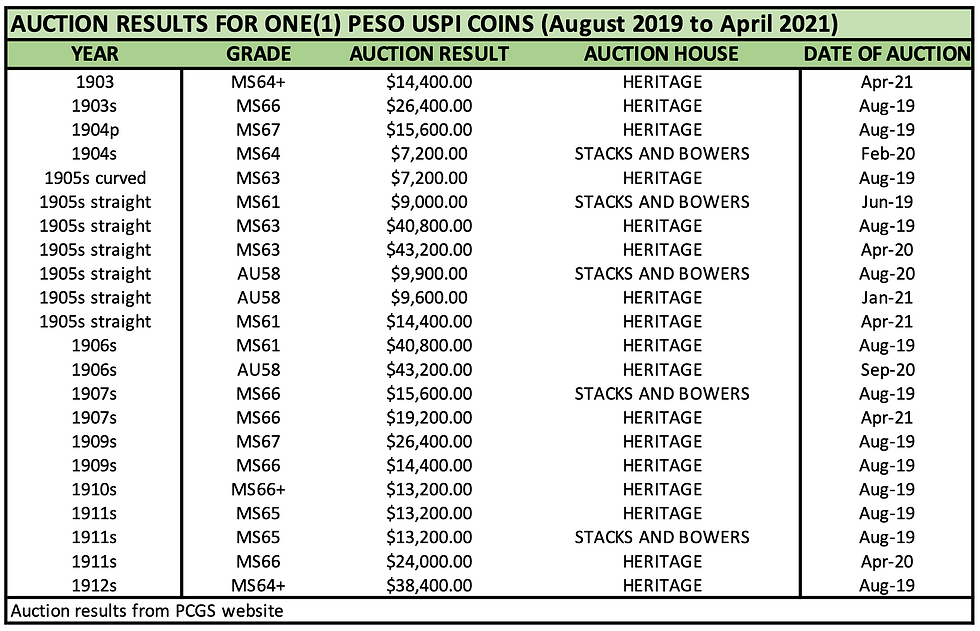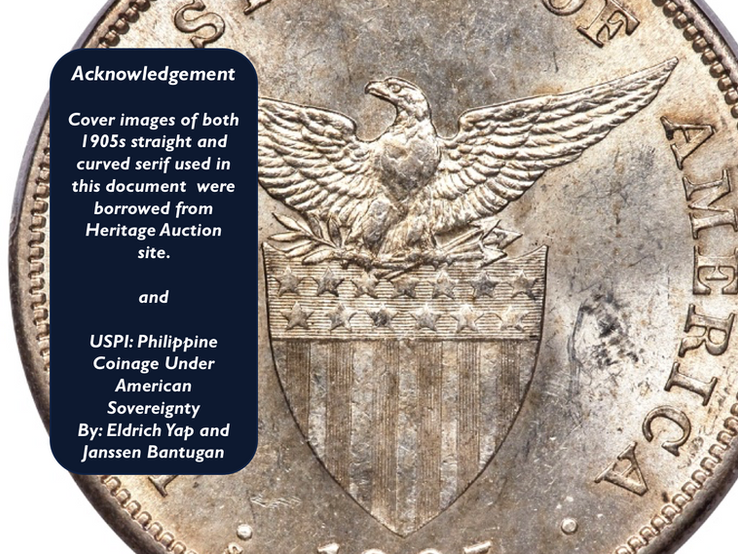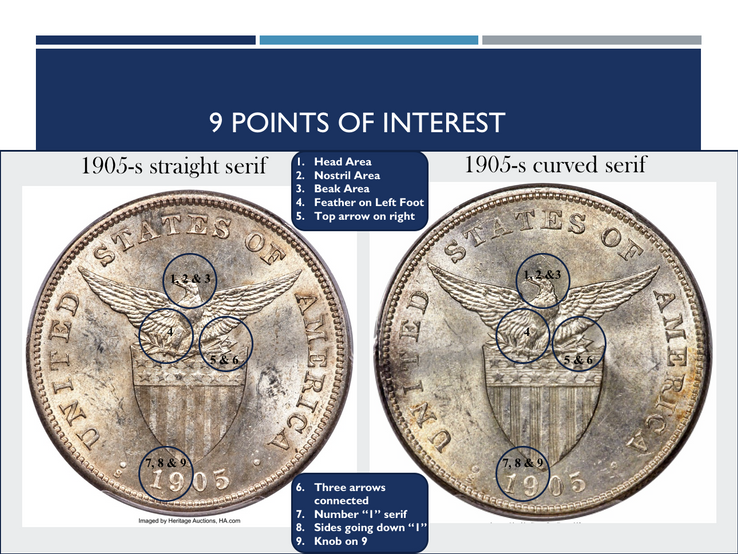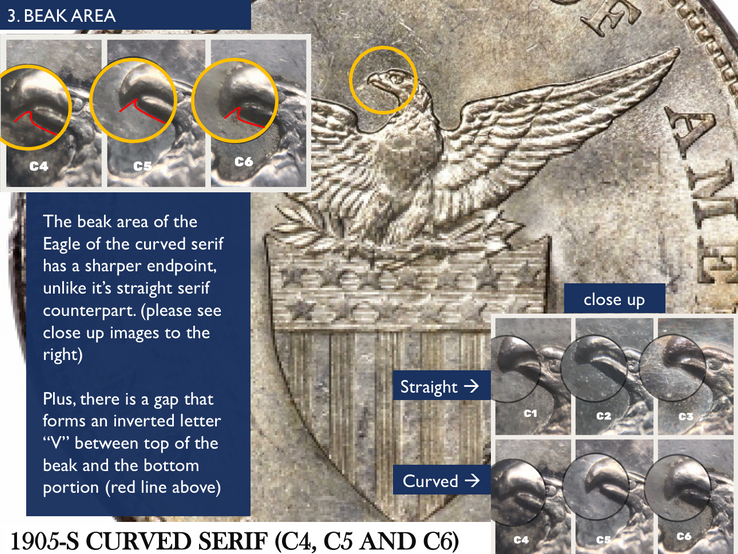The Undervalued 1905s straight serif: Part 2 of My Obsession
- sandylichauco
- Sep 19, 2021
- 11 min read
Updated: Sep 21, 2021

In any major decisions I make, I always ask the basic proverbial questions: "what", "how" and "why"? One-word questions that need to be answered first before any major decision to pour out resources in terms of time or monetary resources that eventually become major investments. My obsession with the 1905s straight serif was no exception. It started with the basic question of what is the straight serif and how to determine if one is indeed considered the Allen16.06a variety of the 1905s USPI One(1) peso. It had been a lingering echo in my mind and I felt I was on to something so I made sure to properly document it.
Last November 2020 I finally found the time to sit down and write a blog about what I felt were the other diagnostics of the One(1) Pesos 1905s straight serif USPI coin. It took awhile to write as I wanted to make sure that the data and information I had gathered 2 years before were shared and written, and of course should be as accurate as possible. Please note that the blog I had written, entitled: "1905s straight serif DIAGNOSTICS: Part 1 of my Obsession" was 2 years in the making. It took me months to gather the data, the images and most especially the actual coins themselves back in 2018. Finally, after I had gathered enough data that I felt sounded plausible and made some sense, I created a presentation to visually show these diagnostics, a process that took another month (for the record these diagnostics I had discovered and documented as far back as June 2018). Attached below is the slide show presentation I had made to start this obsession of mine:
The blog was only written 2 years later, around November of 2020 as I wanted to make sure my "discoveries" went through the usual stress tests and comments from other collectors. Plus, I needed to make sure it was presented well enough for every collector to understand not just from a content perspective but also from a grammar perspective.
A review of the above study will show that I had used 6 samples: 3 straight serif and 3 curved serif coins and I had 9 "points of interest", defined as those major areas on the obverse and reverse of the coin that made them different from each other.

Please refer to the blog for the other details:
As I was able to determine the "what" and the "how" I now come to the most important question of all -- the "WHY." Why single out the 1905s straight serif? Why do I think it is undervalued? Why do I think the 1905s SS still has a lot of room for more price appreciation? Why is it a good investment? Or even more basic, why collect it at all?
PROCEDURE:
In order to truly understand and answer each of these "WHYs", I had to go back to basics and do a study of the population numbers of all 13 coins in the USPI series. These are the numbers reflected and published by the TPGs at their respective sites that show the number of coins graded and slabbed under the Sheldon grading scale. I collated the data for two different periods, 2018 and then the present. These are the same numbers I felt will tell the story of the coins' rarity and scarcity values, which I believe is very important given the number of USPI Peso coins in circulation today. I was lucky that 3 years ago, as I was obsessing about the coin and created the presentation I had laid out above, I was also able to gather the population numbers of all 13 coins in their specific years namely: 1903s, 1903p, 1904s, 1904p, 1905s curved serif, 1905s straight serif, 1906s, 1907, 1908s, 1909s, 1910s, 1911s and 1912s. Part of my obsession I guess, and after gathering the numbers, I totaled the coins and grouped them under certain "grading ranges," which I believe made some sense. Unfortunately I had lost all the raw data, but kept only the totals that I had done at that time.
It is from these totals that I began reconstructing the data and started another process of gathering 2021 population data numbers for this new study to compare to the 2018 totals I was able to save. I had to be consistent with the manner I had collected 3 years ago so that I could easily compare the numbers from this 3-year span. Presented below are the raw numbers as of September 2021 as gathered from all the TPGs and presented consistent with the way I had gathered the numbers in 2018:



As mentioned earlier, I had lost all my raw data from 2018 and had kept only the summary totals. (See Table below for 2018 totals).

Using the same format summary table I had saved for the 2018 numbers, I extracted the totals from the raw numbers I gathered for the 2021 population numbers from each of the TPGs. I segregated the numbers and clustered them into the same three grade ranges I used in 2018: AU50-58+, MS60-63+ and MS64-67. Just by doing this exercise all over again, I discovered one very big change and that is the increase in the number of "+ designation" on the grades of coins, specifically AU58+, MS62+ and MS63+. This increase likely is a clear indication of the increase in the number of quality coins submitted for grading with the TPGs and probably an indication also of the TPGs getting a little stricter in their grading process and procedures.

From these numbers, it was very clear that I was obsessing about the right coin as the 1905s SS managed to hold its own as one of the hardest to find USPI one(1) peso coins in the series. In fact, my theory in 2018 that the 1905s SS should actually dethrone the 1912s One(1) peso and be considered the "queen of the peso" may have been proven correct by these numbers. I would like to emphasize that the numbers in 2018 showed that the 1905s SS was toe-to-toe with the 1906s' as regards scarcity. In fact, at the grade level of MS60-63 the 1905s SS had fewer coins graded and was even tied with the 1906s as observed in the MS64-67 with no coins graded at those levels. But could the same could be said for 2021?
From the above comparison of the 2018 and 2021 total population data, a number of observations, assumptions and conclusions can be derived:
There was a 23.4% increase in the number of coins submitted and graded over this 3 year period -- from 3,765 total coins in 2018 to 4,645 coins in 2021. Within this increase the coin that had the largest rate of increase was the 1905s SS, followed by the 1908s at 52.5% and then the 1907s with 46% increase. It is obvious that this increase could be attributed to the following:
The growing popularity (and value) of the 1905s straight serif, which was a sleeper coin I believe 3 years ago. I mean a "sleeper" in the sense that in 2018 I was still able to buy raw coins for around Php10-15k ($200-300). Today, these raw coins average Php30k-40k ($600-800) if one is lucky enough to find one online, most especially in the numerous Facebook groups and pages, which have become the venues to sell these coins amongst collectors. In fact, when I conducted my first study in 2018 that discussed and talked about the diagnostics of a 1905s SS, the 6 coins I had used as the sample coins for the study were all bought within a period of 2 to 3 months prior to the study. The nicest of which was the AU58 coin, which was purchased in Sept. 2018, regraded and reslabbed with PCGS in October and was upgraded to AU58+ (still the only example in that grade designation amongst the 3 TPGs). It is also very important to note that the results of the auctions at both Stacks and Bowers and Heritage auctions over this period showed significant price increases for this coin:
An AU53 coin sold for $1,140 in February 2019 while another AU53 coin sold for $4,800 in January 2021;
An AU58 sold for $4,800 in August 2019 and then two other AU58 graded 1905s SS coins sold for $9,900 (Aug. 2020) and $9,600 (January 2021);
An MS61 sold for $9,000 in June 2019 and then another MS61 sold for $14,400 in April 2021; and finally
Two coins graded MS63 sold for $40,800 in August 2019 and then another one sold for $43,200 in the April 2020 Heritage Auction.
The increases in the number of graded coins could also be attributed to the hoards of coins being discovered right and left in the Philippines by resourceful dealers and sellers from old-time collectors. Urban legends describe old houses that were built in the early 20th century had USPI coins buried underneath as part of the belief by the owner of the house that it will bring them good luck. There would be coins that were never circulated and left untouched for more than 100 years. Dealers/sellers who discovered these "sources of coins" quickly turned around to submit through the ever-reliable NGC/PCGS accredited resource persons in the Philippines. I have not gotten around to ask them about the volume of submission during this 3 year period, but I am willing to bet that the increase was two to three fold and mostly in the submission of USPI One (1) peso coins. What probably caused that desire to submit and grade these coins is the proverbial wish or desire to discover that "golden ticket" as auction results had reached all time highs for most of the coins in the series:

Please note that the numbers above do not reflect the sale of major graded coins from
small auctions in the Philippines. I, for one am privy to a 1912s raw coin that was bought
for a little bit more than Php200,000 ($4,000), submitted to PCGS and was graded MS64 and was sold for a little above $40,000, all in a period of 1 year.
Given these geometrical increases in coin auction results across most coins during the years outlined above, I am not surprised that there was a corresponding increase in the interest to have coins slabbed and graded during this 3 year period. A comparison of our base numbers in July 2018 and September 2021 reflects this rapid increase. It had

become the business within the dealer community here in Manila (where the business model was very simple) to simply find a raw coin, have it graded and sell it for a song. But the best deal would be to discover a hoard of USPI coins, buy it for silver value or slightly more and then to submit it to the TPGs for grading. Next wait a couple of months, get results and then sell the coin for 2x and as much as 5x. This is probably the best explanation for the increases in the population of coins in the census. The biggest increase is within the MS60-63 grade range with a 28.6% increase followed by the AU50-58 grade range with a 21% increase. I shared these results with one of the USPI collectors here in the Philippines who recently received an award from PCGS for having the top new USPI Philippines Complete Circulation Strikes and Proof Peso (1903-1936) Registry Set. His basic conclusion is that many of these coins, even several often regarded as "key dates", are not particularly scarce in AU and lower MS grades. He further stated that their prices may be considered inflated due to a failure by collectors to recognize that their scarcity is really a high MS phenomenon. But he also believes that the biggest exception are still the 1905s SS and the 1912s particularly as all MS grades for these two dates has remained very scarce over this 3 year period. The numbers above reflect the glaring scarcity of these coins where the 1906s has remained

the king with only a total of 47 coins slabbed and graded within these grade ranges and no coin has graded in the MS64-67 range; notably the 1905s SS has continued to remain equally elusive particularly in MS notwithstanding the fact that it had the highest percentage increase in the number of coins submitted, graded and slabbed in AU and MS during the period. This scarcity attends despite an increase in total of 50 coins in 2018 to 81 coins in 2021, a more than 60% increase over the 3 year period. This increase in submissions clearly is attributable to the the all-time high results for the coin in recent auctions and its close similarity to the 1906s based on recent diagnostics (please see Chapter 5 of the 2nd Edition of the USPI book by Yap and Bantugan). This data confirms my theory that the 1905s SS should replace the 1912s as the "queen of the pesos" given that the 1912s has remained a distant third in terms of scarcity of total coins graded as of today -- particularly when the availability of MS specimens is considered and even if all 3 grade ranges are assessed starting with the AU50-58+:

All three grade ranges consistently show the 1905s SS has been the number 2 coin in the USPI series in terms of scarcity. It has consistently outpaced the other coins despite the growing interest in the coin the past 3 years. It has even beaten the 1912s in terms or rarity and has also established itself as a coin with which to reckon. The prices of 1905s SS the past months reflect that fact, and, even in the low AU grades, the prices have really come on strong and held their own the past months. I note that the top pop 1905s SS is an MS64 example presently registered to a collector/dealer in Chicago in the United States. As 1905s SS Ms 63 examples have rivaled the prices historically captured by 1912s MS64 coins, it would be interesting to see what the 1905s SS MS64 would garner in today’s marketplace.
I guess the biggest question now is what does the future hold for these coins. At this point, it is difficult to determine its course, but just a glance at these numbers would show that there is a long way to go for the KEYs especially at high levels. The mere 6% increase of graded coins at the MS64-67 level clearly reflects the lack of supply of these high-MS coins, and from an investment standpoint the real opportunity clearly remains at the MS64-67 grade range. This likely explains why some of the most advanced collectors choose to retain multiple examples in the highest grade ranges. Even the more common 1907s and 1908s are quality investments at this grade range.
I predict that there will be more coins to be submitted for grading and slabbed as more new collectors come into the hobby and get introduced to the series that appeals to both collectors from the Philippines and the USA. Please note that the numbers above do not reflect the reslabbing of some coins and their cross-over from one TPG to the other. Included in this "reslabbing modus" are those coins that were taken out of their slabs and "technically conserved" to come out of the "details" grade just to be added to the census as straight grades. However, these incidents are mere "blips" in the census and I do not foresee these types of coins to significantly add to the population numbers in the years to come because as the years pass, it would be very difficult to get real quality coins as the supplies of all these coins have been continuously dwindling in the marketplace and the TPGs are getting smarter in determining what coins have been "retouched". Plus, given the historical fact of the period destruction of the 1905s and 1906s coins due to silver price inflation, the number of coins from these years to be added to the census will not significantly affect these population numbers and both coins' scarcity values would remain at the top -- still to be considered the King and Queen of the pesos...which makes my obsession for the 1905s straight serif all worth it.
On that note, we are unsure if these numbers will remain the same in the coming years. It will take another set of gathering, evaluating and analyzing of these coins in another 3 years to determine if the King and the new Queen of the Peso retain their respective crowns. Your thoughts?
(please note: The above blog chose to focus on the 1905s SS straight serif, but the numbers clearly show there remains a staggering number of graded AU and MS coins even for the non-key coins and these numbers over the 3 year period still reflects that there is still some value for these coins.
I also purposely laid out all the numbers of all the coins to get a clearer over-all picture of my theory about the 1905s SS, which was my objective; and to show the reader the numbers behind the coins they are holding on to, whether it be a high AU 1905s curved serif, or a low AU 1910s. Either way I feel that if the reader may not or does not agree with some of my conclusions, I am still able to do them a service by furnishing, collating and laying out in front of the reader the data they clearly need to make decisions moving forward. Data that took 3 years to gather.)
(Acknowledgement: I'd like to thank Mr. Byron Milstead for being my sounding board as I pursued this obsession of mine, ironically our friendship started with a 1905s SS One (1) peso coin)
Sources:
https://www.pcgs.com/pop/detail/u-s-philippines-1903-1945/943
USPI 2nd Edition by Eldrich Yap and Janssen Bantugan (2021)


















































































Comments